This document describes core principles of the Android application
framework, from a high-level, user-centric perspective useful to
interaction and application designers as well as application
developers.
It illustrates activities and tasks with examples, and describes some
of their underlying principles and mechanisms, such as navigation,
multitasking, activity re-use, intents, and the activity stack.
The document also highlights design decisions that are available to you
and what control they give you over the UI of your application.
This document draws examples from several Android applications,
including default applications (such as Dialer) and Google
applications (such as Maps). You can try out the examples yourself in
the Android emulator or on an Android-powered device. If you are using
a device, note that your device may not offer all of the example
applications used in this document.
Be sure to look at the
Design Tips section
for guidelines, tips, and things to avoid. This document is a
complement to Application Fundamentals,
which covers the underlying mechanics for programmers.
Applications, Activities, Activity Stack and Tasks
Four fundamental concepts in the Android system that are helpful for you to understand are:
- Applications
- Activities
- Activity Stack
- Tasks
Applications
An Android application typically consists of one or more
related, loosely bound activities for the user to interact with, typically bundled up
in a single file (with an .apk suffix). Android ships with a rich set
of applications that may include email, calendar, browser, maps, text
messaging, contacts, camera, dialer, music player, settings and
others.
Android has an application launcher available at the Home screen,
typically in a sliding drawer which displays applications as icons,
which the user can pick to start an application.
Activities
Activities are the main building blocks of Android
applications. When you create an application, you can assemble it from
activities that you create and from activities you re-use from other
applications. These activities are bound at runtime, so that newly
installed applications can take advantage of already installed
activities. Once assembled, activities work together to form a
cohesive user interface. An activity has a distinct visual user
interface designed around a single, well-bounded purpose, such as
viewing, editing, dialing the phone, taking a photo, searching,
sending data, starting a voice command, or performing some other type
of user action. Any application that presents anything on the display
must have at least one activity responsible for that display.
When using an Android device, as the user moves through the user
interface they start activities one after the other, totally oblivious
to the underlying behavior — to them the experience should be
seamless, activity after activity,
task after
task.
An activity handles a particular type of content (data) and accepts a
set of related user actions. In general, each activity has a
lifecycle that is independent of the other
activities in its application or task — each activity is
launched (started) independently, and the user or system can start,
run, pause, resume, stop and restart it as needed. Because of this
independence, activities can be re-used and replaced by other
activities in a variety of ways.
The Dialer application is an example of an application that consists
basically of four activities: dialer, contacts list, view contact, and
new contact, as shown in the following screenshots:
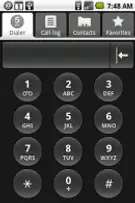
Dialer
|
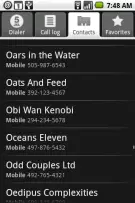
Contacts
|
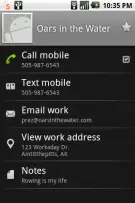
View Contact
|
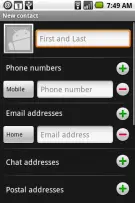
New Contact
|
Here are other examples of applications and the activities they might contain:
-
Email - activities to view folders, view list of messages,
view a message, compose a message, and set up an account
-
Calendar - activities to view day, view week, view month, view
agenda, edit an event, edit preferences, and view an alert
-
Camera - activities for running the camera, viewing the list
of pictures, viewing a picture, cropping a picture, running
the camcorder, viewing the list of movies, and viewing a movie
-
Game - one activity to play the game, typically another for setup
-
Maps - one activity to view a location on a map, a second for lists
(such as turn list or friend list), and a third for details
(friend location, status, photo)
An activity is the most prominent of four components of an
application. The other components are service, content provider and
broadcast receiver. For more details on activities, see Activity in
Application Components.
Activity Stack
As the user moves from activity to activity, across applications, the
Android system keeps a linear navigation history of activities the
user has visited. This is the activity stack, also known as the
back stack. In general, when a user starts a new activity, it is added
to the activity stack, so that pressing BACK displays the previous
activity on the stack. However, the user cannot use the BACK key to go
back further than the last visit to Home. The adding of an activity to
the current stack happens whether or not that activity begins a new
task (as long as that task was started
without going Home), so going back can let the user go back to
activities in previous tasks. The user can get to tasks earlier than
the most recent Home by selecting its root activity from the
application launcher, a shortcut, or the "Recent tasks" screen.
Activities are the only things that can be added to the activity stack
— views, windows, menus, and dialogs cannot. That is, when
designing the navigation, if you have screen A and you want the user
to be able go to a subsequent screen B and then use the BACK key to go
back to screen A, then the screen A needs to be implemented as an
activity. The one exception to this rule is if your application
and manages the navigation itself.
Tasks
A task is the sequence of activities the user follows to
accomplish an objective, regardless of which applications the
activities belong to. Until a new task is explicitly specified (see
"Interrupting the Task"), all activities the user starts are
considered to be part of the current task. It's notable that these
activities can be in any application — that is, all in the same
application or in different ones. That is, a task that starts out in
contacts can continue, by choosing an email address, to an email
activity and then, by attaching a file, to a picture gallery to pick
from. Contacts, email and picture gallery are all separate
applications.
The activity that starts a task is called the root activity.
It is often, but not necessarily, started from the application
launcher, Home screen shortcut or "Recent tasks" switcher (a long
press on Home on some devices). The user can return to a task by
choosing the icon for its root activity the same way they started the
task. Once inside a task, the BACK key goes to previous activities in
that task. The activity stack is made up of one or more tasks.
Here are some examples of tasks:
-
Send a text message with an attachment
-
View a YouTube video and share it by email with someone else
Interrupting the Task - An important property of a task is that
the user can interrupt what they're doing (their task) to perform a
different task, then are able to return to where they left off to
complete the original task. The idea is that users can run multiple
tasks simultaneously and switch between them. There are two primary
ways to jump off to that other task — in both cases the user
should be able to return to where they were before the interruption:
-
User is interrupted by a notification – a notification appears and the user wants to act on it
-
User deciding to perform another task – user just presses Home and starts an application
Of course, there are exceptions to the rules. Beyond the two ways just
mentioned, there is a third way to start a task, and that is by
starting an activity that defines itself as a new task. Maps and
Browser are two applications that do this. For example, choosing an
address in an email starts the Maps activity as a new task, and
choosing a link in an email starts the Browser activity as a new
task. In these cases, the BACK key will return to the previous
activity in a different task (Email), because it was not started from
Home.
A Tour of Activities and Tasks
The following examples illustrate basic principles for applications,
activities, the activity stack, the BACK key, tasks and intents. It
shows how the system responds to user actions such as starting
activities and switching between tasks. With most of these examples
you can follow along, launching activities on your device as
indicated.
Starting an Activity from Home
Home is the starting place for most applications. (Some applications
can be launched only from other applications.) When the user touches
an icon in the application launcher (or a shortcut on the Home
screen), the main activity for that application is launched into the
foreground where it has user focus. As shown in the following figure,
the user action of going Home and touching the Email icon launches the
List Messages activity of the Email application. The Home activity
remains stopped in the background, ready to restart when called on by
the user.
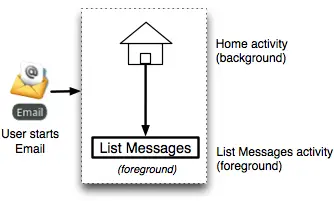
Navigating Away from an Activity with BACK and HOME keys
An activity can keep or lose its state depending on how the user
leaves the activity — by the HOME or BACK key.
By default, pressing the BACK key finishes (destroys) the current
activity and displays the previous activity to the user. In the
following figure, the user starts email by touching the Email icon in
the Home screen, which displays a list of email messages. The user
scrolls down the list (changing its initial state). Pressing BACK
destroys the List Messages activity and returns to the previous
activity, which is Home. If the user re-launches Email, it would
re-load the messages and display its initial, non-scrolled state.
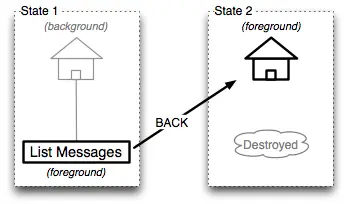
In the above example, pressing BACK goes to Home because it was the
last activity the user was viewing. But if the user had gotten to List
Message from some other activity, then pressing BACK would have
returned there.
By contrast, the next figure shows the user leaving List Messages by
pressing HOME instead of BACK — the List Messages activity is
stopped and moved to the background rather than being
destroyed. Starting Email again from its icon would simply bring the
List Messages activity to the foreground (changing it from stopped to
running) in the same scrolled state the user last left it.
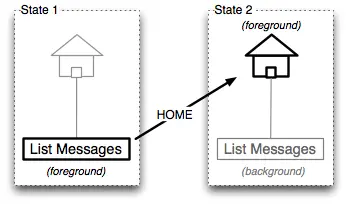
Exceptions. Some background activities return to their initial
screen (they lose any state, such as scrolling) when they are brought
to the foreground. This is true for Contacts and Gallery. If the user
chooses Home > Contacts then chooses a contact, they are viewing
the details of a contact. If they start again by choosing Home >
Contacts, they are presented with the initial list of contacts rather
than the contact they were last viewing. Contacts is designed this way
because this initial screen is the main entry point for the
application with four tabs for accessing the full range of features.
In addition, not all activities have the behavior that they are
destroyed when BACK is pressed. When the user starts playing music in
the Music application and then presses BACK, the application overrides
the normal back behavior, preventing the player activity from being
destroyed, and continues playing music, even though its activity is no
longer visible — as a visual substitute, the Music application
places a notification in the status bar so the user still has an easy
way to get to the application to stop or control the music. Note that
you can write an activity to stop when its screen is no longer
visible, or to continue running in the background — the latter
was chosen for the music player.
Re-using an Activity
When activity A starts activity B in a different application, activity
B is said to be re-used. This use case normally takes place
because activity A is lacking a capability and can find it in activity B.
Contacts Re-Uses Gallery to Get a Picture - The Contacts
activity has a field for a picture of a contact, but the Gallery is
normally where pictures are kept. So Contacts can re-use the Gallery
activity to get a picture. This is a good example of re-use of the
Gallery activity. The following figure illustrates the sequence of
activities to do this (up to crop). This is how it's done: The user
chooses Contacts, selects the contact for viewing, chooses MENU >
Edit contact and touches the picture field, which launches the Gallery
activity. The user then chooses the picture they want, crops and saves
it. Saving it causes the picture to be inserted into the picture field
in the contact.
Notice the Gallery returns a picture to the Contacts application that
started it. The next example illustrates re-use of an activity that
does not return a result. Also notice that the following figure is
illustrates the navigation history through the activities, or the
activity stack — the user can back up through each activity all
the way to Home.
When designing an application, it's good to think about how it can
re-use activities in other applications, and how your activities might
be re-used by other applications. If you add an activity with the same
intent filter as an
exisiting activity, then the system presents the user with a choice
between the activities.
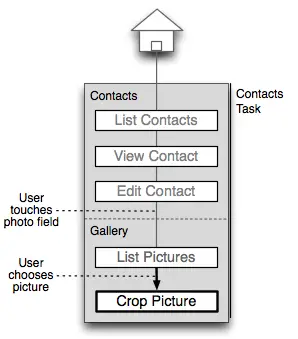
Gallery Re-Uses Messaging for Sharing a Picture - Sharing is
another good example of one application re-using an activity from a
different application. As shown in the following figure, the user
starts Gallery, picks a picture to view, chooses MENU > Share, and
picks "Messaging". This starts the Messaging activity, creates a new
message and attaches the original picture to it. The user then fills
in the "To" field, writes a short message and sends it. User focus
remains in the Messaging program. If the user wants to go back to the
Gallery, they must press the BACK key. (The user can back up through
each activity all the way to Home.)
In contrast to the previous example, this re-use of the Messaging
activity does not return anything to the Gallery activity that started it.
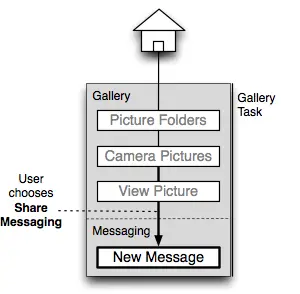
Both of these examples illustrate tasks — a sequence of
activities that accomplish an objective. Each case uses activities
from two different applications to get the job done.
Replacing an Activity
This is the use case where activity A replaces activity B in a
different application. This situation normally happens because
activity A is better at doing the job than activity B. In other words,
A and B are equivalent enough that A can replace B. This case stands
in contrast with re-using an activity, where A and B are quite
different activities and supplement each other.
In this example, the user has downloaded a replacement for the Phone
Ringtone activity, called Rings Extended. Now when they go to
Settings, Sound & Display, Phone Ringtone, the system presents
them with a choice between the Android System's ringtone activity and
the new one. This dialog box has an option to remember their choice
"Use by default for this action". When they choose "Rings Extended",
that activity loads, replacing the original Android ringtone activity.
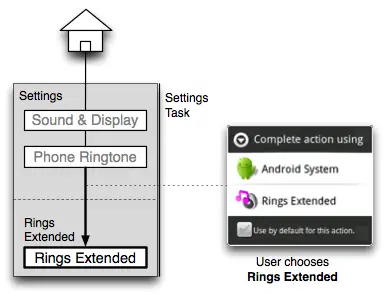
Multitasking
As previously noted, when an activity has been launched, the user can
go to Home and launch a second activity without destroying the first
activity. This scenario demonstrates launching the Maps application.
-
State 1 - The user launches the View Map activity and searches
for a map location. Let's say the network is slow, so the map is
taking an unusually long taking time to draw.
-
State 2 - The user wants to do something else while they're
waiting, so they press HOME, which does not interrupt the map's
network connection and allows the map to continue loading in the
background.
Note that when you write an activity, you can make it stop or
continue running when it is moved to the background (see
onStop() in Activity Lifecycle).
For activities that download data from the network, it's recommended
to let them continue downloading so the user can multi-task.
-
State 3 - The map activity is now running in the background,
with Home in the foreground. The user then launches the Calendar
activity, which launches into the foreground, taking user focus,
where they view today's calendar (as indicated by the heavy
outline).

-
State 4 - The user presses Home, then Maps to return to the map, which by now has fully loaded.
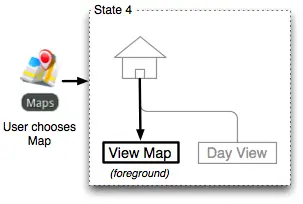
The application launcher at Home has launched "View Map" and "Day
View" activities into separate tasks, hence the system is
multitasking — running multiple tasks.
Launching from Two Entry Points
Every application must have at least one entry point — a way
for the user or system to access activities inside the
application. Each icon in the application launcher at home
represents an entry point. Applications can also from another
application. Each activity is a potential entry point into the
application.
The phone application has two entry points: Contacts and Dialer. A
user entering from Contacts can choose a phone number to launch the
Dialer. As shown in the following figure, a user could choose the
Contacts icon to launch the Contacts activity, then pick a phone
number to launch the Dialer activity and dial the phone.
Once the user is inside the application, they can access other
activities, such as New Contact and Edit Contact, through tabs, menu
items, list items, onscreen buttons, or other user interface
controls.
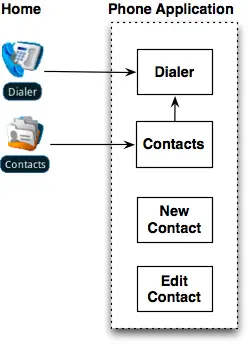
Intents
When the user takes an action on some data, such as touching a
mailto:[email protected] link, they are actually initiating an Intent
object, or just an intent, which then gets resolved to a
particular component (we consider only activity components here).
So, the result of a user touching a mailto: link is an Intent object
that the system tries to match to an activity. If that Intent object was
written explicitly naming an activity (an explicit intent),
then the system immediately launches that activity in response to the user
action. However, if that Intent object was written without naming an
activity (an implicit intent), the system compares the Intent
object to the intent filters of available activities. If more
than one activity can handle the action and data, the system
displays an activity chooser for the user to choose from.
This example of touching the mailto: link is shown in the following
figure. If the device has two email applications set up, when a user
touches a mailto: email address on a web page, the result is an
Intent object which displays a dialog box with a choice between the
two activities to compose an email (Gmail and Email).
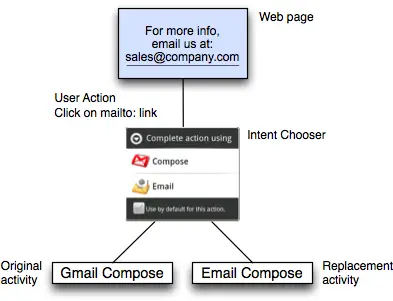
Here are some examples of Intent objects and the activities they resolve to:
-
View the list of contacts - resolves to a contact list viewer activity
-
View a particular contact - resolves to a contact viewer activity
-
Edit a particular contact - resolves to a contact editor activity
-
Send to a particular email - resolves to an email activity
-
Dial a phone number - resolves to a phone dialer activity
-
View the list of images - resolves to an image list viewer activity
-
View a particular image - resolves to an image viewer activity
-
Crop a particular image - resolves to an image cropper activity
Notice that an Intent object specifies two things, an action and data:
-
A generic action to be performed. In these examples: view, edit, dial or crop
-
The specific data to be acted on. In these examples: the list of contacts, a particular contact, a phone number, the list of images, or a particular image
Note that any user action to start an activity from the
application launcher at Home is an explicit intent to a specific
activity. Likewise, some activities launch private activities
within their application as explicit intents so no other activity
can access them.
For more on intents, see Intent class and
intent filters.
Switching Between Tasks
This scenario shows how the user can switch between two tasks. In
this example, the user writes a text message, attaches a picture,
but before they are done they glance at their calendar. They then
return to where they left off, attaching the picture and sending the
message.
-
Start first task. You want to send a text message and attach a photo. You would choose:
Home > Messaging > New message > MENU > Attach
> Pictures. This last step launches the picture gallery
for picking a photo. Notice that picture gallery is an
activity in a separate application.
At this point, before you have picked a picture, you decide
to stop and glance at your calendar, which is a separate
task. Because the current activity has no button to go
directly to the Calendar, you need to start from Home.
-
Start second task. You choose Home > Calendar to
look at a calendar event. Calendar launches from Home as a new
task because the application launcher creates a new task for
each application it launches.
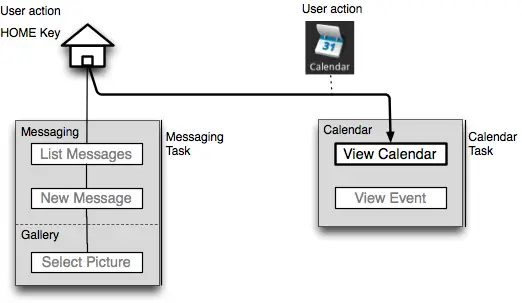
-
Switch to first task and complete it. When done looking
at the Calendar, you can return to attaching the picture by
starting the root activity again for that task: choose Home
> Messaging, which takes you not to Messaging, but directly
to the Picture gallery, where you left off. You can then pick
a photo, which is added to the message, you send the message
and you're done with the first task.
Design Tips
The following are tips and guidelines for application designers and developers.
When writing an activity that won't be re-used, don't specify intent filters — use explicit intents
If you're writing an activity that you don't want other activities
to use, be sure not to add any intent filters to that activity. This
applies to an activity that will be launched only from the
application launcher or from other activities inside your
application. Instead, just create intents specifying the explicit
component to launch — that is, explicit intents. In this case,
there's just no need for intent filters. Intent filters are
published to all other applications, so if you make an intent
filter, what you're doing is publishing access to your activity,
which means you can cause unintentional security holes.
When reusing an activity owned by others, handle the case where no activity matches
Your applications can re-use activities made available from other
applications. In doing so, you cannot presume your intent will always
be resolved to a matching external activity — you must handle the case
where no application installed on the device can handle the intent.
You can either test that an activity matches the intent, which you can do
before starting the activity, or catch an exception if starting the
activity fails. Both approaches are descibed in the blog posting
Can
I use this Intent?.
To test whether an intent can be resolved, your code can query the package manager.
The blog post provides an example in the isIntentAvailable() helper method.
You can perform this test when initializing the user interface.
For instance, you could disable the user control that initiates
the Intent object, or display a message to the user that lets them go
to a location, such as the Market, to download its application.
In this way, your code can start the activity (using either startActivity()
or startActivityForResult()) only if the intent has tested to resolve
to an activity that is actually present.
Consider how you want your activities to be launched or used by other applications
As a designer or developer, it's up to you to determine how users
start your application and the activities in it. As an application
is a set of activities, the user can start these activities from
Home or from another application.
-
Launch your main activity from an icon at Home - If
your application can run standalone, it should probably be
started by the user touching an icon in application
launcher (typically implemented as a sliding drawer on the
Home screen), or from a shortcut icon on the Home screen, or
from the task switcher. (The mechanism for this is for the
activity to have an
intent filter with action MAIN and
category LAUNCHER.)
-
Launch your activity from within another application -
Perhaps your activities are meant for re-use. For example,
many applications have data they want to share with other
users. Activities that can share data with other users include
email, text messaging and uploading to a public website.
If one or more of your activities can be an alternative to an
existing activity in another application, you can make it
available to users at the point they request that
activity. For example, if your activity can send data to
others (such as by email, text messaging, or uploading),
consider setting up that activity to appear as a choice to the
user. To give a specific example, Gallery enables a user to
view and share pictures. When the user chooses "Share" from
the menus, the system compares the "Share" request (an Intent
object) to available activities (by looking at their intent
filters) and displays choices to share. In this case, it
matches Email, Gmail, Messaging and Picassa. If your activity
can send a picture or upload it to a website, all it needs to
do is make itself available for sharing (by setting its intent
filter).
Another activity can start your activity either with or without expecting a result back.
-
Start an activity expecting a result - This approach
is closed loop, where the activity being started must either
return a valid result or be canceled. In the previous
examples of sharing a photo from a Gallery, the user ends up
back in the Gallery after completing the send or upload
procedure. These are examples of starting an activity
external to the Gallery. (Such an activity is started with
startActivityForResult().)
-
Start an activity not expecting a result - This
approach is open-ended. An example is choosing an house
address in an email message (or web page), where the Maps
activity is started to map the location. No result from maps
is expected to be returned to the email message; the user
can return by pressing the BACK key. (Such an activity is
started with startActivity().)
-
Launch your activity only from within another
application - The previous cases of sharing by way of
Email, Gmail, Messaging and Picassa (from within Gallery) are
all activities that can also be started from icons in the
application launcher at Home. In contrast, the activities for
cropping a picture and attaching a file cannot be started from
Home, because they do not stand alone and require a
context.
In fact, not all applications have icons and can be started from
Home. Take for example a small app that is infrequently used and
replaces existing functionality, that already has a natural entry
point inside an existing application. For example, an Android phone
typically has a built-in ringtone picker that can be selected from
the sound settings of the Settings application. A custom ringtone
picker application that you write could be launched by an intent
identical to the built-in ringtone picker. At the point where the
user chooses "Phone ringtone", they are presented with a dialog
letting them choose between "Android System" and your ringtone
picker (and letting them save their choice) as shown in the
following figure. A ringtone is something you set infrequently, and
already has a well-defined starting point, so probably does not need
an application icon at Home.
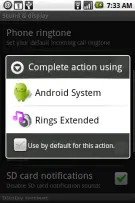
-
Launch two or more main activities within a single
application from separate icon at Home - As we have
defined it, all the code in a single .apk file is considered
to be one application. You can write an application
that contains two main activities launchable from Home.
The Camera.apk application is a good example of an application that
contains two independent main activities — Camera and
Camcorder — that each have their own icons in application
launcher, that can be launched separately, and so appear to the user
as separate applications. They both share use of the same lens, and
both store their images (still and moving) in the Gallery.
In order for your application to contain two different, independent
activities launchable from Home, you must define them to be
associated with different tasks. (This means setting the main
activity for each task to a different task affinity — in this case,
"com.android.camera" and "com.android.videocamera".)
Contacts and Dialer are another example of two main activities
launchable from Home that reside in the same application.
-
Making your application available as a widget - An
application can also display a portion of itself as an app widget, embedded in Home or another
application, and receive periodic updates.
Allow your activities to be added to the current task
If your activities can be started from another application, allow
them to be added to the current task
(or an existing task it has an affinity with). Having activities
added to a task enables the user to switch between a task that
contains your activities and other tasks. Exceptions are
your activities that have only one instance.
For this behavior, your activity should have a launch
mode of standard or singleTop rather than singleTask or
singleInstance. These modes also enable multiple instances of your
activity to be run.
Notifications should let the user easily get back to the previous activity
Applications that are in the background or not running can have
services that send out notifications to the user letting them know about
events of interest. Two examples are Calendar, which can send out notifications of
upcoming events, and Email, which can send out notifications when new
messages arrive. One of the user interface guidelines is that when the
user is in activity A, gets a notification for activity B and
picks that notification, when they press the BACK key, they should
go back to activity A.
The following scenario shows how the activity stack should work
when the user responds to a notification.
-
User is creating a new event in Calendar. They realize they
need to copy part of an email message into this event
-
The user chooses Home > Gmail
-
While in Gmail, they receive a notification from Calendar for an upcoming meeting
-
So they choose that notification, which takes them to a
dedicated Calendar activity that displays brief details of the
upcoming meeting
-
The user chooses this short notice to view further details
-
When done viewing the event, the user presses the BACK
key. They should be taken to Gmail, which is where they were
when they took the notification
This behavior doesn't necessarily happen by default.
Notifications generally happen primarily in one of two ways:
-
The chosen activity is dedicated for notification only -
For example, when the user receives a
Calendar notification, choosing that
notification starts a special activity that displays a list
of upcoming calendar events — this view is available only
from the notification, not through the Calendar's own user
interface. After viewing this upcoming event, to ensure that
the user pressing the BACK key will return to the activity
the user was in when they picked the notification, you would
make sure this dedicated activity does not have the same
task affinity as the Calendar or any other activity. (You do
this by setting task affinity to the empty string, which
means it has no affinity to anything.) The explanation for
this follows.
Because of the way tasks work, if the taskAffinity of the
dedicated activity is kept as its default, then pressing the
BACK key (in step 6, above) would go to Calendar, rather
than Gmail. The reason is that, by default, all activities
in a given application have the same task
affinity. Therefore, the task affinity of the dedicated
activity matches the Calendar task, which is already running
in step 1. This means in step 4, choosing the notification
brings the existing Calendar event (in step 1) forward and
starts the dedicated activity on top of it. This is not
what you want to have happen. Setting the dedicated
activity's taskAffinity to empty string fixes this.
-
The chosen activity is not dedicated, but always comes to
the foreground in its initial state - For example, in
response to a notification, when the Gmail application comes
to the foreground, it always presents the list of conversations.
You can ensure this happens by setting a "clear top" flag in the
intent that the notification triggers. This ensures that when the
activity is launched, it displays its initial activity, preventing
Gmail from coming to the foreground in whatever state the user last
happened to be viewing it. (To do this, you put FLAG_ACTIVITY_CLEAR_TOP in the intent you pass to startActivity()).
There are other ways to handle notifications, such as bringing the
activity to the foreground, set to display specific data, such as
displaying the text message thread for the person who just sent a
new text message.
A notification always starts an activity as a new task (that is, it
puts FLAG_ACTIVITY_NEW_TASK in the intent it
passes to startActivity()). This is done because interruptions to a
task should not become part of that task.
Use the notification system — don't use dialog boxes in place of notifications
If your background service needs to notify a user, use the standard
notification system — don't use a dialog or toast to notify
them. A dialog or toast would immediately take focus and interrupt
the user, taking focus away from what they were doing: the user
could be in the middle of typing text the moment the dialog appears
and could accidentally act on the dialog. Users are used to dealing
with notifications and can pull down the notification shade at their
convenience to respond to your message.
Don't take over the BACK key unless you absolutely need to
As a user navigates from one activity to the next, the system adds
them to the activity stack. This forms a navigation history that is
accessible with the BACK key. Most activities are relatively limited
in scope, with just one set of data, such as viewing a list of
contacts, composing an email, or taking a photo. But what if your
application is one big activity with several pages of content and
needs finer-grained control of the BACK key? Examples of such Google
applications are the Browser, which can have several web pages open
at once, and Maps, which can have several layers of geographic data
to switch between. Both of these applications take control of the
BACK key and maintain their own internal back stacks that operate
only when these applications have focus.
For example, Maps uses layers to present different
information on a map to the user: displaying the location of a
search result, displaying locations of friends, and displaying a
line for a street path providing direction between points. Maps
stores these layers in its own history so the BACK key can return to
a previous layer.
Similarly, Browser uses browser windows to present different
web pages to the user. Each window has its own navigation history,
equivalent to tabs in a browser in a desktop operating system (such
as Windows, Macintosh or Linux). For example, if you did a Google
web search in one window of the Android Browser, clicking on a link
in the search results displays a web page in that same window, and
then pressing BACK would to the search results page. Pressing
BACK goes to a previous window only if the current window was
launched from that previous window. If the user keeps pressing
back, they will eventually leave the browser activity and return
Home.
